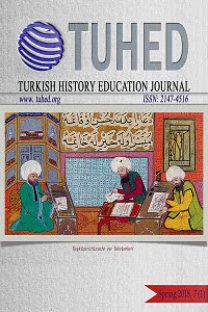TEVHİD-İ TEDRİSAT KANUNUNUN AMAÇ GERÇEKLEŞTİRME BAŞARISINA DAİR BİR İNCELEME
Bu
makalede, Tevhid-i Tedrisat Kanunu ile başlayan ve yüzyılını doldurma eşiğinde
bulunan Cumhuriyetin Eğitim Devrimi, amaç gerçekleştirme başarısı bakımından
literatür ve belgeler desteğinde kuramsal/tarihsel bakış yöntemiyle irdelenmiş
ve değerlendirilmiştir. Vaki değerlendirme sonucu konu hakkında erişilen kritik
bulgular; hukuki referansı Tevhid-i Tedrisat Kanunu, kök değerleri ise Millilik
ve Laiklik olan eğitim devriminin, gelinen durum itibariyle farklı sosyal hayat
alanlarına hitap eden cumhuriyet devrimleri arasında amaç gerçekleştirme
başarısı en sınırlı kalan devrimsel girişim olduğu, bahse konu neticenin beşeri
fenomenlerde tarih bilinci eşliğinde öznel nadas yöntemiyle sağlanan
gelenek-yenilik kutupsal sinerjisi üzerinden dikey mutasyon-aşkınlık-devrimsel
büyüme kanuniyetine aykırı bir yola girilmiş olması, bu meyanda millilik ve
laiklik değerlerinin sürecin başında buharlaşmasıyla oluşan tepkisel iklimde
baskılanmış köklerin toprak altında vahşileşerek toprak üstü oluşumları bloke
etmiş olması, kökten beslenerek kökleri üzerinde büyüyemediği için hırpalanmış
durumdaki formal sistemin mevcudiyet eksikliğinde ise gelenekçi teist
fırsatçıların millilik, pragmatist-ateist fırsatçıların da laiklik damarını
istismar ederek gölge sistem halinde devreye girmesiyle ilişkili olduğudur.
Gerçekten de hem yaşam enerjisi tükenmiş gölge medrese-tekke modelinin hala itibar
görmesi ve halktan güç devşirmeye devam eden korsan yıkıcı gidişatı, hem de
anlam paralizasyonuyla malül aynı tepkisel iklimde diğer rövanşist fırsatçılara
yönelen teveccüh, insanların formal sistemle tinsel meşruiyetten yoksun
mesafeli ilişkisi ve doğanın boşluk kaldırmaması nedeniyle insan/eğitim
tefecilerinin merdiven altı korsan çözümlerine tepkisel akışından öte bir anlam
ifade etmemektedir.
Anahtar Kelimeler:
Tevhid-İ Tedrisat, Eğitim Devrimi, Amaç Gerçekleştirme Başarısı
An INVESTIGATION on the GOAL ACHIEVEMENT SUCCESS of the UNIFICATION of EDUCATION ACT (TEHVID‐I TEDRISAT)
In this article, the Education Revolution of the
Republic, which started with the Law on Unification of Education and is on the
threshold of filling the century, was examined and evaluated in a
theoretical/historical perspective with the support of literature and documents
in terms of purpose achievement. Critical findings on the subject are as
follows; a) The educational revolution of which legal reference is The Law on
Unification of Education and the root values are Nationality and laicism, as of
now is the most unproductive revolutionary initiative among the republican
revolutions that appeal to different social life areas, b) This result was led
to prefer a way that was inconsistent with the law of vertical
mutation-transcendence revolutionary growth accompanied by the consciousness of
history in human phenomena through the polar synergy of tradition-innovation
provided by the subjective fallow method c) In this respect, the suppressed
roots got wild underground and blocked the formations above the ground in a
reactive climate caused by the disappearance of nationality and secularism
values at the beginning of the process, d) It is associated with a shadow
system that was activated by the traditionalist theist opportunists exploiting
the nationalism and also the pragmatist-atheist opportunists exploiting the
secularism through taking advantage of the formal system that was battered due
to the fact that it cannot be nourished with its roots. Indeed, both the
life-drained shadow madrasah-Islamic Tekke model is still respected and the
devastating illegal progression continues to derive power from the people, and
the complaisance towards other revanchist opportunists in the same reactive
climate does not make any sense more than a reaction to human/education usurers'
illegal solutions due to the distant relationship of people with formal system
devoid of spiritual legitimacy and the perspective as nature does not accept
any emptiness.
___
- Akgündüz, H. (1997). Klasik dönem Osmanlı medrese sistemi. İstanbul: Bellek.
- Akgündüz, H. (1998). Tarihi gelişim içinde medreseler ve üniversiteler. Diyarbakır: Gençlik.
- Akgündüz, H. (1998). Eğitim sorunlarına tarihsel bakış yöntemi. Diyarbakır: Gençlik.
- Akgündüz, H. (2013). Hurafe ve gerçek ikileminde eğitim. İstanbul: Hayat.
- Akyüz, Y. (2012). Türkiye’de öğretmenlerin toplumsal değişmedeki etkileri. Ankara: Pegem.
- Akyüz, Y. (2013). Türk eğitim tarihi. Ankara: Pegem.
- Dursun, T. ve Hassan, Ü. (2008). İbn-i Haldun’da uygarlıkların yükselişi ve çöküşü. İstanbul: Kaynak.
- Denkel, A. (2007). Nesne ve öznellik (Çev. A. Kanat). İstanbul: Doğu-Batı.
- Dennet, D.C. (1999). Aklın türleri, Çev. H. Baykara. İstanbul: Varlık.
- Erdoğan, İ. (2002). Türk eğitim sistemi. İstanbul: Sistem.
- Erdoğan, İ. (2015). Eğitim bilimleri ve milli eğitime dair. Ankara: Nobel.
- Ergün, M .(2018). Modern eğitim sistemlerinin doğuşu ve gelişimi. Ankara: Pegem.
- Gutek, G.L. (1998). Eğitime felsefi ve ideolojik yaklaşımlar (Çev. N. Kale). Ankara: Ütopya.
- Gürdoğan, N. (2017). Görünmeyen üniversite. İstanbul: İz.
- Kongar, E. (1995). Toplumsal değişme ve Türkiye gerçeği. İstanbul: Bilgi.
- Köseoğlu, N. (1995). Türk Dünyası tarihi ve Türk Medeniyeti üzerine düşünceler. İstanbul: Ötüken.
- Levis, B. (1991). Modern Türkiye’nin doğuşu (Çev. M. Kıratlı). Ankara: Arkadaş.
- Milli Eğitim Bakanlığı (MEB). (2018). 2023 Eğitim misyonu. Erişim: http://2023vizyonu.meb.gov.tr/
- Mengüşoğlu, T. (1998). İnsan felsefesi. İstanbul: Doğu-Batı.
- Richard, H. H. (1972). Organizations: Structure and process. Englewood Cliffs: Prentice-Hall.
- Rotzak, T. (1995). Bilincin evrimi (Çev. B. Muhib). İstanbul: İnsan.
- Sakaoğlu, N. (2018). Türkiye eğitim tarihi. İstanbul: Alfa.
- Tevhid-Tedrisat Kanunu: Yayımlandığı R. Gazete: Tarih: 6/3/1340 Sayı: 63.
- Tevhid-Tedrisat Kanunu Sureti: CCA 2-4-8.
- Tevhid-i Tedrisat Kanunu’na Göre Okullarda Uygulanacak Esaslar: CCA 142-1-3.
- Tevhid-i Tedrisat Kanununa Göre Medaris-i İlmiye İle Darulhilafeler Hakkında Vilayetlere Gönderilen Genelge: CCA 3-27-2.
- Yücer, H.M. (2003). Osmanlı toplumunda tasavvuf 19. yüzyıl. İstanbul: İnsan.
- ISSN: 2147-4516
- Yayın Aralığı: Yılda 2 Sayı
- Başlangıç: 2012
- Yayıncı: Ahmet Şimşek
Sayıdaki Diğer Makaleler
ORTAOKUL ÖĞRENCİLERİNİN KRONOLOJİ BECERİLERİNİN SAPTANMASINA YÖNELİK BİR ÇALIŞMA
Tekin ÇELİKKAYA, Mutlu KÜRÜMLÜOĞLU
Çeviri: TARİH TEDRİSATI - Abdullah CEVDET
Galip ÖNER, Tuba ÇENGELCİ KÖSE
BEN-ANLATILARI: TARİHSEL KAYNAK OLARAK İMKANLARI, SINIRLARI
PROF. HILARY COOPER İLE KÜÇÜK ÇOCUKLARLA TARİH ÖĞRETİMİ ÜZERİNE BİR GÖRÜŞME
TAŞRADA DARÜLMUALLİMATLARIN AÇILIŞI ve TARİHSEL GELİŞİMİ
Sevim CEYLAN DUMANOĞLU, Memet YETİŞGİN
Çeviri: 21. YÜZYILDA KALİTELİ TARİH EĞİTİMİ: PRENSİPLER ve KILAVUZLAR
SOME THOUGHTS on HISTORY TEACHING
TEVHİD-İ TEDRİSAT KANUNUNUN AMAÇ GERÇEKLEŞTİRME BAŞARISINA DAİR BİR İNCELEME
